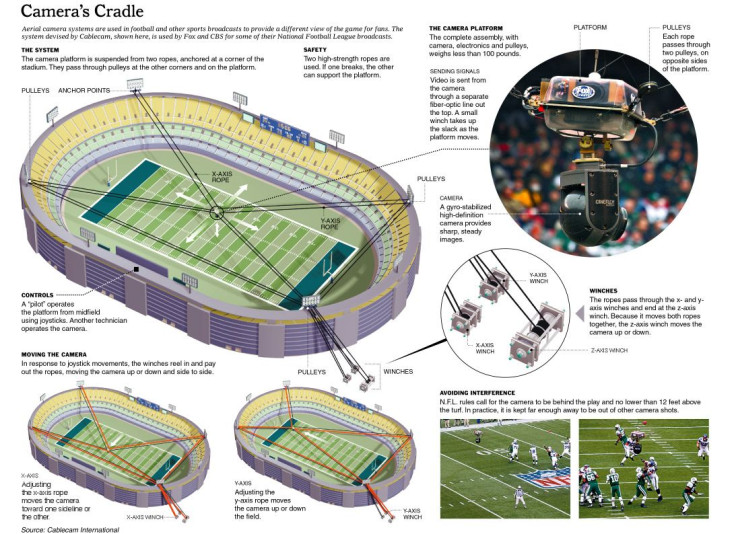Super Bowl 2014 Cameras: 5 Shooters Revolutionizing The NFL

Anyone who has watched a football game -- or any sporting event for that matter -- knows that it takes a lot of cameras and operators, teams of editors, directors and scores of technical crew to produce the three-hour show. A typical football game has approximately 10 cameras in operation and a major show like "Monday Night Football" may have double that amount. This weekend’s Super Bowl contest between the Denver Broncos and the Seattle Seahawks may have upwards of 30 cameras filming the most-watched sporting event in the country. Here are five different cameras that are changing the way we watch football.
SkyCam
Suspended above the game, this aerial camera provides viewers with the best angle on all of the action. This is probably the most technically arduous system in the entire sport. The camera is suspended by two high-strength ropes that create an x and y axis, which allows the camera to move anywhere across the field. A series of winches and pulleys loosens and tightens the ropes, creating not only the movement around the field, but the z-axis as well, giving the camera operator the option to zoom down onto the field for the close-up action we all crave.
The camera operators are required by the league to stay behind the play and at least 12 feet off of the ground so as to not impede play. Because of these rules, the SkyCam is rarely a problem in the game. However, in two college ball games the SkyCam has interfered. In 2011, Marquis Maze claimed a 73-yard punt by LSU punter Brad Wing hit the SkyCam cables, causing him to miss the return. Perhaps more notably, at the 2011 Insight Bowl in Tempe, Ariz. A SkyCam fell almost hitting Iowa receiver Martin McNutt Jr. Luckily he wasn’t hit, only sustaining a scratch as the cables entangled him.
Slow Motion
High-speed film cameras have been a part of the league for years. NFL Films, run by Steve Sabel, have been using slow-motion cameras that film at 60, 96 or 120 frames per second to capture the drama and excitement of the game. In 2009, “super-duper” slow-motion replays debuted, filming at an astonishing 1000 frames per second, giving viewers an extreme view of the action. Slo-mo cameras are used by armchair-refs and officials alike to get a better perspective on the sport, making calls all that more accurate.
The Goodyear Blimp
The usefulness of the eye-in-the-sky blimp cameras is relatively limited, but they are still a staple of the game. The Goodyear blimp has been covering football games since 1955, almost 60 years of aerial coverage. Zoomed out images of stadiums and parking lots give at home watchers an angle that people going to the game don’t get. Instead, visitors get to see the gigantic Eaglevision signage which shows more than just the weather. However, Goodyear is planning on moving away from the blimp in 2014, launching their new semi-rigid airships, called the Zeppelin NTs.
Helmet Cam
At the beginning of the 2013 season, it was reported that Bill Belachick and the New England Patriots have implemented a helmet cam system on QB Tom Brady during practices. Belachick was notoriously quiet about the novelty camera, saying only that it was a new technology they planned on trying. However effective or ineffective it is for the coaching staff, it could mean that viewers get one more angle on the game. Imagine the bump segments going in and out of time outs.
BallCam
While no professional or amateur football club has implemented yet, graduate students Kris Katani and Kodai Horita at the Carnegie Mellon University’s Robotics Institute have integrated a wide-angle compact camera into a foam and rubber football, creating the BallCam. The relatively unwatchable raw video shows exactly how fast a football can spiral. However, Katani and Horita, alongside Hideki Sasaki and Professor Hideki Hoike of the University of Electro-Communications in Tokyo, created an algorithm that stabilizes the images and creates a watchable flight video. While the BallCam is still in the early stages of production, it is exciting to think how a final product might be integrated into the professional sport.
© Copyright IBTimes 2024. All rights reserved.





















